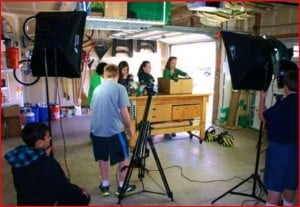ISTE 2013 Day 2
Session 1
“Inquiry is the personal path of questioning, investigating, and reasoning that takes us from not knowing to knowing” Suzie Boss
Signposts to Better Projects: How to take thinking deeper in digital age PBL – Suzie Boss and Mike Gwaltney’s session was one of the first entries on my conference planner as a “must see” session! Suzie has already posted the session slideshow (below).
And my takeaways:
1.Set stage for inquiry – Example: Prior to announcing a new project, place banners and posters outside and inside the school as “grabbers.”
2. Create a culture of collaboration – Example: Make the world safe for thinking – the marshmallow challenge (TED talk) – http://marshmallowchallenge.com/TED_Talk.html – will get you thinking about safe environments for learning.
3. Invite feedback – Example: Use class blog to create feedback loop. Consider joining a collaborative blogging community such as Quadblogging.
4. Think about thinking – provide some deliberate ways for kids to think about their thinking, to develop thinking routines. Think/Pair/Share, for example, is a quick way to collect thoughts, put them out, and get some response. Use Google Docs to promote reflection, using targeted questions (how’s this assignment compare to another project). Have students create videos as formative assessment. For more ideas on helping students develop a “thinking routine,” check out Peter Pappas’ A Taxonomy of Reflection and Project Zero: Thinking Routines.
5. Think as experts do – How do you encourage thinking as experts do? Put kids in the role off experts. Show Thinking like a Historian chart. What are the ways that people think in your discipline. Kids need academic vocabulary of the discipline. “It’s relatively unnatural for a young person to be interested in the past – they haven’t lived long enough.” Use current events. Checkout George Mayo’s Transitions project. His students had to think like illustrators for project; therefore, George brought in a husband and wife team.
6. Watch for spirals (project creates more energy) – what’s the opportunity. Is it worth taking project further.
Checkout Ghost Jacket from Lost & Found Films – a project that transitioned from cleaning up a mess at a school site to sending jackets to those who needed them. And, of course, what better example of a spiral could Suzie use than Jim Bentley’s student film academy’s award-winning documentary (a continuing/spiraling project) on hazardous waste: Recharging Our World (very proud of my inspiring district colleague and his incredible students:-).
7. Assessment: Think about assessment throughout the project, formative not just summative. Grading on process across categories vs. a single grade on final project/product …. Oh my, this is brilliant!!! Mike Gwaltney has created PBL skills “hit the bull’s eye” sort of a rubric – for formative and self assessment to “get students thinking about their own learning.”
And a few more books to add to my summer reading list, per Mike Gwaltney’s recommendations: Teaching with Your Mouth Shut (David Finkel) and Understanding by Design (by Grant Wiggins). If you have not already read Suzie’s Reinventing Project-Based Learning, this is a great starting point for your PBL journey, as well as the Buck Foundation’s PBL website.
Session 2
Design Your Digital Tattoo – Helping Students Design Their Digital Image – Adina Sullivan pointed out what should be obvious to all of us who teach, model, and promote digital citizenship: the term “digital footprint” should be replaced with “digital tattoo.” Having watched my son, a few years back, go through the process of tattoo removal, I can second Adina’s perspective that it’s a difficult process, requiring numerous (painful) sessions, and that the tattoo is never fully eliminated. Tattoos are a much more accurate symbol of our online personas than footprints – especially the footprints in the sand images.
Takeaways:
- Digital Tattoo – What’s Yours – Although I was familiar with this site, having posted several of their videos to the Digital ID Building Identities page, I hadn’t noticed the resources posted to the home page for tracking your “tattoo.” I really like having additional sites beyond Google:
- Search yourself. Use pipl.com to find out what comes up about you. Try spezify for a visual representation of your identity or (more importantly) how the internet sees you.
- Consider your tattoo. Your Digital Dossier demonstrates how identity is formed online. Be Findable is an example of how your online identity can help you.”
- A few more investigation tools:
- personas.media.mit.edu
- intelius.com
- socialmention.com – Kind of a wow factor, so if nothing comes up with your name, try a world leader, such as Nelson Mandela
- kred.com – I’ve had a number of colleagues asking me about Kred after Joyce Valenza blogged about it. I like Adina’s caution about using programs that require logging in via Twitter or Facebook.
Great job, Adina!
Session 3
Mashup and Remix: Reading, Writing, Research, and Reaching the World – I arrived late to this session (got side tracked walking through the display tables), so I missed Bill Bass’s part of the presentation. With only a 1/2 hour remaining, I wondered how my NWP/NCTE colleague and friend Sandy Hayes could possibly make a case for fair use in that time limit. She did! Here’s a link to the PDF with many of the links from the slideshow. As soon as Sandy posts the link to the slideshow, I add it to this post. Another great presentation from Sandy!


